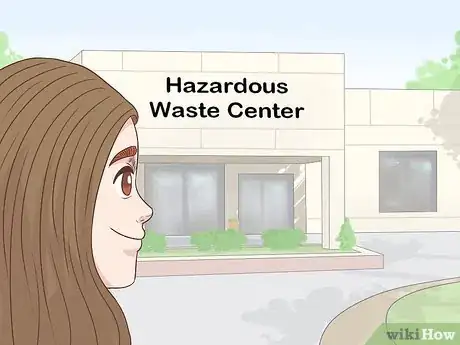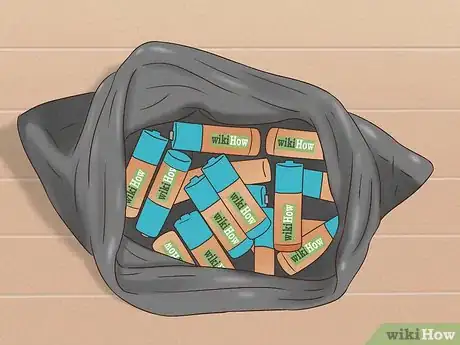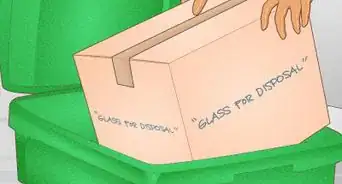This article was co-authored by Kathryn Kellogg and by wikiHow staff writer, Danielle Blinka, MA, MPA. Kathryn Kellogg is the founder of goingzerowaste.com, a lifestyle website dedicated to breaking eco-friendly living down into a simple step-by-step process with lots of positivity and love. She's the author of 101 Ways to Go Zero Waste and spokesperson for plastic-free living for National Geographic.
There are 7 references cited in this article, which can be found at the bottom of the page.
This article has been viewed 67,583 times.
Lithium and lithium-ion (or Li-ion) batteries are commonly used to power computers, cellphones, digital cameras, watches, and other electronics. Lithium-ion batteries are often rechargeable, while regular lithium batteries are usually single-use. Unlike alkaline batteries, lithium batteries are reactive and contain hazardous materials. For this reason, you should not put them in the trash. To dispose of lithium batteries, you'll need to take them to a recycling center, which is easy to find online.
Steps
Finding a Recycling Center
-
1Keep batteries out of your regular recycling bin. Household batteries are recycled separately from other items. Mixing batteries in with other recyclables can result in a fire, as the battery can spark. You'll need to take your batteries to a facility that collects batteries.
- Even a battery that has lost its charge can spark.
- If you’re recycling an item that contains rechargeable batteries, like a cell phone or laptop, you may need to take the batteries out first and recycle them separately.
EXPERT TIPKathryn Kellogg is the founder of goingzerowaste.com, a lifestyle website dedicated to breaking eco-friendly living down into a simple step-by-step process with lots of positivity and love. She's the author of 101 Ways to Go Zero Waste and spokesperson for plastic-free living for National Geographic.Sustainability Specialist
 Kathryn Kellogg
Kathryn Kellogg
Sustainability SpecialistOur Expert Agrees: Don't put batteries in your curbside recycling bin. Whenever items go through the materials recycling facility, they're compacted. This can cause batteries to explode, which poses a risk for workers at the facility.
-
2Search for a store that collects lithium batteries for a convenient option. Many chain and big box stores recycle various types of batteries on behalf of customers. Stores often collect batteries for free, but some charge a small fee for certain types of lithium batteries. These services are meant to help with household waste, so the stores may limit how many batteries you can turn in at a time.[1]
- You can search for a store or recycling center in your area here: https://earth911.com/.
- Several chain stores that sell electronics or batteries collect lithium batteries for recycling, including the following:
- Best Buy
- Staples
- Lowes
- Home Depot
Advertisement -
3Ask your local library or community center about battery collection. Some libraries and community centers have battery collection bins or host battery collection events. While not all areas offer this service, it's a good idea to check with your local library or community center.[2]
- For example, they may have a special recycling bin where you can deposit batteries.
- They may collect the batteries on certain days, so check in advance to make sure your batteries will be collected.
-
4Take them to a household hazardous waste center if your area has one. Some local governments collect household hazardous waste from citizens, which includes lithium batteries. In some cases, they may have a designated center that collects the items year-round, which is called a household hazardous waste center. However, some areas host recurring collection events for hazardous waste.[3]
- You can find your local center by visiting your state or local government's website.
- If your area doesn't have a household hazardous waste center, see if your local or regional government hosts a Household Hazardous Waste Collection event. These events often occur regularly, such as annually.[4]
-
5Consider using a mail-in program if it's more convenient. A mail-in program can be a great option if you regularly need to recycle lithium batteries. For example, you might work in an office that uses lithium batteries. Mail-in programs are also helpful if you don't live close to a recycling collection center.[5]
- You may be able to mail in the battery to the manufacturer.
- To find a mail-in program, search online for an option that meets your needs. For example, you might try https://biggreenbox.com/ or http://www.wm.com/residential/recycle-by-mail.jsp.
- You may need to purchase supplies to mail in your batteries, which you can buy online from recycling sites.
Turning in Your Batteries
-
1Call to confirm lithium batteries are accepted and check for fees. Some collection sites only collect certain types of batteries, so check to make sure the site collects lithium batteries.[6] Although some centers will take your batteries for free, lithium and lithium-ion batteries sometimes require a fee.
- If the center collects a fee, check with other collection sites to see if there is a free option in your area.
-
2Tape over the ends of your battery using clear or electrical tape. Since dead batteries can still spark, the ends of the battery can be dangerous. Tape helps prevent sparking or the discharge of energy. As soon as you remove the battery from your electronic item, cover the ends in tape.[7]
- You can safely layer the tape over the ends.
-
3Place your battery in a plastic bag, as an alternative. You can tape it prior to bagging it, but this isn't necessary. It's best to leave the bag unsealed if you store it, as the battery can give off gases. If you're mailing it, seal each battery in a separate bag.[8]
- If you're leaving the bag unsealed, wrap it around the battery to fully cover the battery.
-
4Bag your batteries separately if you use a plastic bag. If they're stored together, batteries can spark and cause a fire, even if the charge is almost gone. For safety purposes, keep them separate.
- Once the batteries are bagged, they can be placed next to each other.
-
5Put them in a vented plastic container or cardboard box, if storing. Batteries often give off gases, so they should not be stored in an airtight container. Choose a box that allows air to escape, or put the batteries in a cardboard box.[9]
- You can still close the box, just make sure it's not sealed.
-
6Keep lithium batteries separate from other types of batteries. Combining different types of batteries can result in a reaction, even if they are taped. You need to place them in separate storage containers.[10]
- You can place the boxes in the same area, as long as the batteries are in separate containers.
-
7Store the batteries in a cool, dry place until disposal. It's best to avoid extreme temperatures, since batteries can be reactive. Similarly, it's best to keep the batteries dry. Place your used lithium batteries in a pantry, cabinet, or closet.[11]
-
8Take your battery to the collection site. Bring your batteries during the collection times, and make sure you bring enough money to cover any fees. They will take your batteries and send them to an appropriate disposal site. In some cases, the contents will be reused.
- Keep in mind some collection sites limit how many batteries you can turn in at a time, since these programs are intended for household waste. They're more likely to limit lithium-ion batteries. For example, you may be able to turn in just 3 batteries at a time.[12]
-
9Mail in your battery if it's more convenient for you. Follow the packaging instructions from the manufacturer or collection center that is accepting the batteries. In most cases, this will involve taping the ends and sealing the batteries in a plastic bag. You may also need to label the package as containing batteries.
- In some cases, you may need to purchase a kit to mail in your batteries for recycling.[13]
References
- ↑ https://www.pca.state.mn.us/living-green/household-batteries
- ↑ https://www.hennepin.us/~/media/hennepinus/residents/recycling/documents/battery-recycling.pdf
- ↑ https://www.pca.state.mn.us/living-green/household-batteries
- ↑ https://www.colorado.gov/pacific/cdphe/household-batteries
- ↑ https://earth911.com/recycling-guide/how-to-recycle-single-use-batteries/
- ↑ https://ewaste.ee.washington.edu/consumers/battery-recycling/
- ↑ https://www.hennepin.us/~/media/hennepinus/residents/recycling/documents/battery-recycling.pdf
- ↑ https://www.hennepin.us/~/media/hennepinus/residents/recycling/documents/battery-recycling.pdf
- ↑ https://www.pca.state.mn.us/living-green/household-batteries
About This Article
If you need to dispose of lithium batteries, look for a local recycling center instead of throwing them in the trash, which can cause a fire. To find a store near you that collects lithium batteries, go to earth911.com and search for your area. Alternatively, next time you’re shopping, try to stop at a Best Buy, Staples, Lowes, or Home Depot, as these chain stores usually have a box where you can recycle old batteries. You can also look on your local government’s official website to see if your area has a dedicated hazardous waste center. If not, they might host a regular Household Hazardous Waste Collection event. Once you find a place that will take your batteries, tape over the ends and keep them separate from other types of batteries to prevent them from sparking. For more tips, like how to send your batteries to a mail-in program, read on!








































































